NO! Sled dogs are very close relatives to wolves built and evolved in harsh winter climates, and wolves are as tough as they come. Thick coats allow them to sleep outside in the snow with no shelter. Most sled dogs don’t need this coat as they have insulated dog houses and kennels to keep them out of the elements. In most cases, a long thick coat will hamper the performance of a sled dog making them overheat even at sub zero temperatures. Along with many other traits, sled dogs are selectively bred for a specific purpose. Performance and durability in cold climates.
Dog pads are made of keratin which is dead or callused skin that provides a natural sole. This is why your dog can run on rocks, sand, grass, snow, ice, and have no effects on the bottom on their feet. Dog pads heal extremely fast with proper care. Snow itself is 90-95% air and is a great insulator where ice, cement, metal, and tarmac are NOT insulators and can be much colder than snow.
BOOTIE FACTS
You may have seen sled dogs with booties on. The sole purpose of booties is to protect the webbing on a dogs foot it does nothing to help keep a dogs feet warm. Humid and dry snow can soften the skin (kind of like dishwater hands) and produce fissures. Fissures are long cracks in the webbing of a dogs foot, kind of like a paper cut. This can be uncomfortable for some dogs and a lot of dogs don’t show any signs of fissures. Most mushers use a combination of a special salve put into the webbing of the feet and a cordura bootie.
During warmer temperatures (26-32F) booties can actually slow down a dog team and potentially cause overheating. Dogs cool themselves naturally through their feet and the lack of contact with cool ground can cause a dog to get hot.
Many sprint mushers like ourselves, only put booties on the rear of the dog if needed. It’s best to NOT use booties at all while sprinting. Due to the high speeds dogs achieve when sprinting, the chances of injuries increase significantly. Putting a bootie on a sprint sled dog takes away from it’s natural traction which can lead to shoulder and wrist injuries. We only use booties if it’s absolutely necessary.


